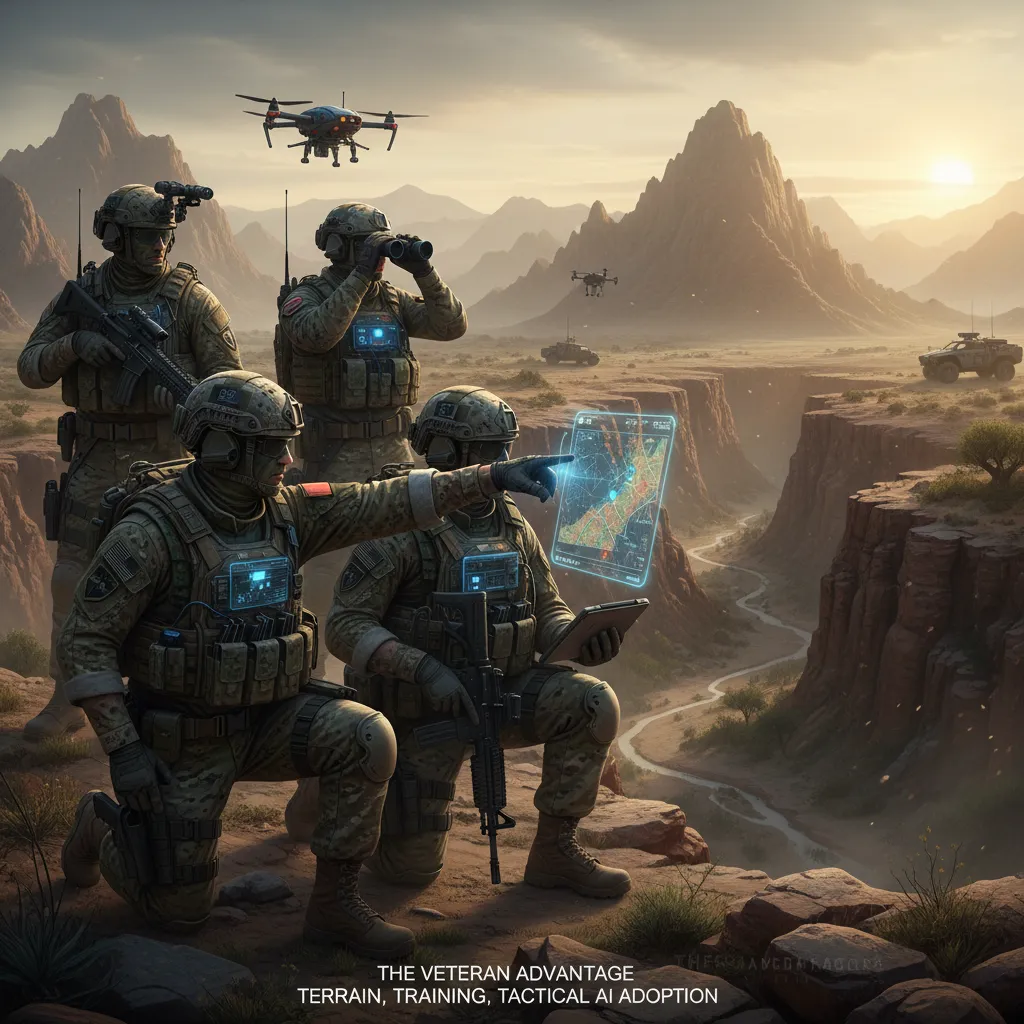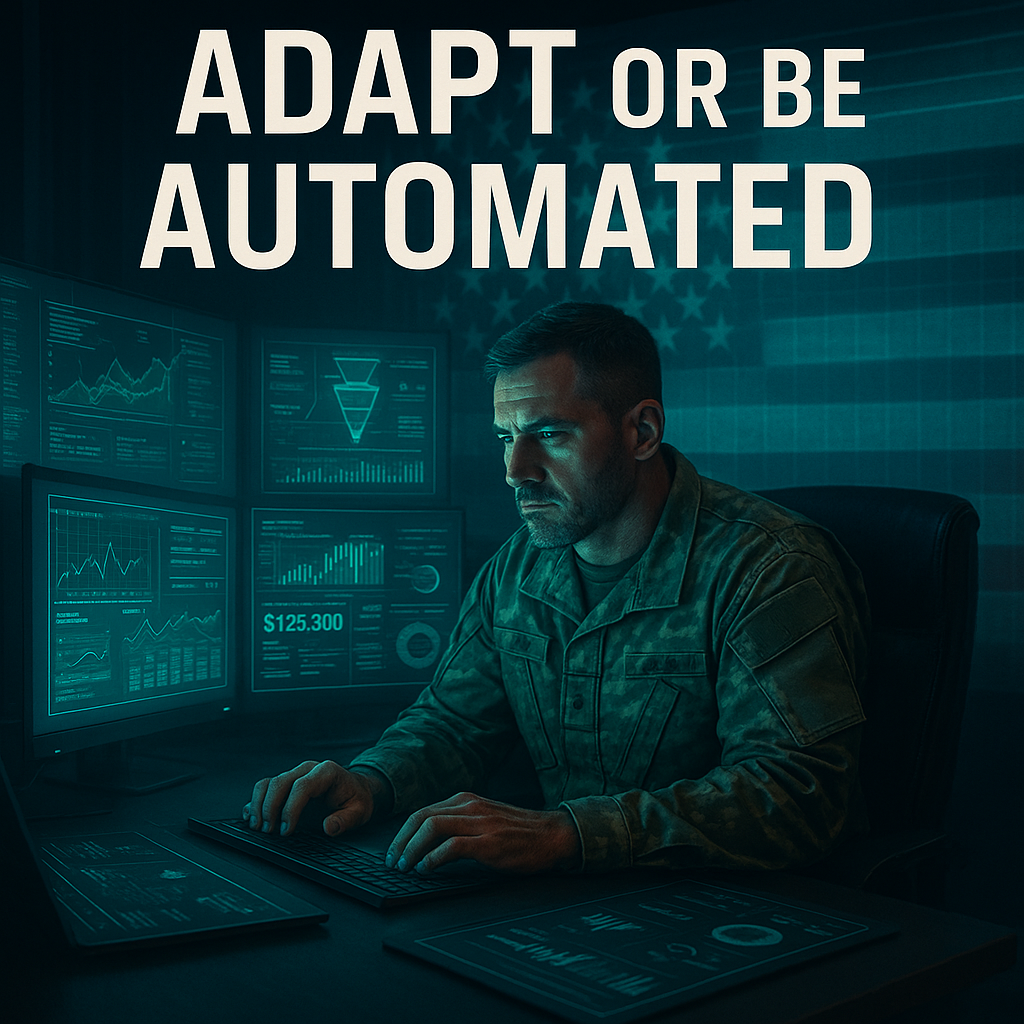When I traded my fatigues for civvies, I thought my toughest battles were behind me. That was until I ran headfirst into the tidal wave called artificial intelligence. From burger-flipping robots to AI writing newsletters (hey, like this one!), tech was transforming every civilian gig. But here's the twist: veterans are uniquely built for this new front. We know how to navigate chaos and adapt under fire. It's time to channel that grit into the digital battlefield—and come out on top, not steamrolled by progress.
From Boots to Bots: My Stumble Into AI (And Why I Laughed Anyway)
When I first traded my combat boots for business casual, I thought the hardest part would be figuring out what to do with my hands during Zoom calls. Turns out, the real challenge was facing a new kind of battlefield: the world of AI tools and business automation. I’ll never forget my first encounter with artificial intelligence—and trust me, it was less “Terminator” and more “tech support comedy.”
My First AI Tool Fumble
I remember sitting at my kitchen table, coffee in hand, ready to “optimize my workflow” like all the business gurus promised. I opened this shiny new AI tool, expecting it to be my secret weapon. The dashboard looked like someone mashed up a spaceship control panel with a tax return. I clicked around, trying to find the “easy button,” and somehow ended up with an ad for “AI girlfriends.” Not exactly the kind of automated support I was hoping for.
I laughed so hard I nearly spilled my coffee. But that moment broke the ice. If I could survive night land navigation with a broken GPS, I could figure out how to use AI—eventually.
Turning Confusion Into Curiosity
After that first stumble, I realized something: AI isn’t the enemy. It’s just a new squad member—one you have to train and get to know. I started treating every new AI tool like a piece of field gear. You don’t just toss it in your ruck and hope for the best. You test it, break it, and learn how it can help you complete the mission.
Veterans are no strangers to unpredictable tech. Radios that only work when you stand on one foot, night vision that fogs up at the worst time, and GPS units that love to “recalculate.” Adapting to business automation with AI felt the same. The key was to stay curious, keep laughing, and remember that every tool has a manual—even if you have to write it yourself.
AI: Your Digital Battle Buddy
AI is amplifying us, not replacing us. It’s your digital battle buddy that never takes leave.
Once I got past the learning curve, I started using AI to automate my content, sales funnels, and customer support. Suddenly, I was saving hours every week—early pilots show AI can save up to 10 hours a month. That’s more time for family, hobbies, or just catching up on sleep (without anyone banging on the door at 0500).
The stress dropped. My free time grew. And I felt that old mission-accomplished rush—except this time, I wasn’t dodging mortars or risking a bad barracks haircut. I was outmaneuvering burnout and building something new, with AI as my never-tired, never-hungry teammate.
Veteran Wisdom Meets AI Automation
If you can operate a convoy, you can operate ChatGPT.
Every new tool is just another piece of gear to master.
Laughter and adaptability are your best assets—on any battlefield.
So, if you’re worried about artificial intelligence taking over, remember: it’s just another mission. And veterans? We were built for this terrain.

The Veteran Advantage: Terrain, Training, and Tactical AI Adoption
When I first heard “AI Workforce,” I pictured a bunch of robots in formation, waiting for inspection. Turns out, the real battlefield is digital—and veterans are built for this new terrain. If there’s one thing military life teaches you, it’s how to thrive when the map changes. Artificial Intelligence is just the latest unfamiliar ground, and we know how to read the terrain, adapt, and move out.
From Convoys to ChatGPT: Translating Military Skills to AI Adoption
Let’s get real: if you can operate a convoy through Baghdad, you can probably master ChatGPT faster than you learned to use the radio. The skills we picked up—logistics, leadership, and problem-solving—are exactly what the AI Workforce needs. In the field, you don’t panic when the plan changes; you improvise, adapt, and overcome. That mindset is gold in the world of Artificial Intelligence, where the only constant is change.
Logistics: Moving supplies in a war zone? Now it’s about moving data and automating workflows.
Leadership: Leading a squad? Now it’s leading a team through digital transformation.
Problem-Solving: Fixing a Humvee under fire? Now it’s troubleshooting AI tools and workflows.
AI adoption isn’t about being a tech genius. It’s about being willing to learn, adapt, and keep pushing forward—exactly what veterans do best.
Veterans Affairs: Leading the Charge in AI Workforce Development
Here’s something that should make every veteran sit up: the Department of Veterans Affairs is all-in on AI. In just one year, the VA’s AI use cases jumped from 40 to 229. Generative AI projects? From 1 to 27. That’s not just growth—it’s a full-on surge. The VA is building an AI-capable workforce, focusing on high-impact, practical applications like medical imaging and support services. If you’re transitioning out, this is a sign: the future is digital, and veterans are needed on this front.
Year | AI Use Cases | Generative AI Projects |
|---|---|---|
2023 | 40 | 1 |
2024 | 229 | 27 |
Veterans Affairs isn’t just adopting AI—they’re investing in veterans to lead the charge. That means training, resources, and real opportunities for those ready to step up and own the digital mission.
Tactical AI Adoption: There’s Always a Manual
Let’s be honest—AI can look intimidating at first. But so did the first time you saw a map of your deployment zone. The trick? There’s always a manual, a YouTube tutorial, or a battle buddy who’s figured it out. Tactical adoption of AI means you don’t fear the tech—you learn it, test it, and use it to your advantage. That’s how you stay ahead.
The future doesn’t belong to those who wait — it belongs to those who build.
AI is the new terrain, and veterans are built for terrain. The digital age isn’t about waiting for orders—it’s about taking the initiative, learning the tools, and leading from the front.

Deploying AI Like a Pro: Freedom Ops, Automation, and the Digital Mission Plan
When I first heard about AI Entrepreneurship, I pictured a bunch of Silicon Valley types in hoodies, not a bunch of veterans like us. But here’s the truth: AI is just the new form of firepower—and we’re teaching veterans how to aim. That’s the heart of Freedom Ops AI. We’re not waiting for permission. We’re not standing in line for jobs that might disappear tomorrow. We’re deploying our own Digital Mission Plans and letting Business Automation do the heavy lifting.
Embracing AI as Firepower
Let’s be real—nobody joined the military because they loved paperwork. But in the civilian world, it’s easy to get buried under repetitive tasks. That’s where Artificial Intelligence comes in. With the right AI tools, you can automate everything from scheduling to customer support. Imagine having a digital battle buddy who never sleeps, never complains, and always has your six. That’s what business automation is all about: freeing you up to focus on strategy, connection, and creativity.
Automate your workload: Let AI handle the admin, so you can focus on the mission.
Create multiple income streams: Use automation to launch side hustles, digital products, or consulting gigs—without burning out.
Reclaim your time freedom: No more 9-to-5 grind. Set your own hours and let AI cover the night watch.
Freedom Ops AI: The Veteran’s Digital Arsenal
Freedom Ops AI isn’t just another online course. It’s a veteran-focused program designed to upskill you in Digital Skills and launch your own AI-powered business. We know you’ve already mastered logistics, leadership, and adapting under fire. Now, we’re showing you how to mix those skills with AI to unlock new paths—no permission needed.
AI is just the new form of firepower — and we’re teaching veterans how to aim.
With Freedom Ops, you don’t have to be a coder or a tech genius. We break down the tools, walk you through the mission plan, and help you deploy automation step by step. The goal? Turn you into an AI-literate entrepreneur who can outmaneuver the job market and thrive in the digital age.
Why Automation Matters for Veterans
Here’s the secret: AI tools can automate the boring stuff. That means less time on grunt work and more time building relationships, creating value, and growing your business. Whether you’re running an online store, coaching, or freelancing, automation lets you scale up without burning out. It’s the digital version of calling in air support—let the bots handle the routine while you lead the charge.
Let AI Handle the Night Watch
Remember those endless night shifts? Now, your AI battle buddy can take over. Set up your automations, monitor your dashboards, and get your time (and sanity) back. The mission is clear: use AI to create freedom, not just another job.
Ready to deploy your first AI-powered business? Let’s get you on the digital battlefield—where veterans don’t just survive, they thrive.

Wild Card: Boots, Bots, and Barracks Humor—Keeping It Human in an Automated World
Let’s be honest—if there’s one thing the military taught us, it’s that you can’t survive the chaos without a sense of humor. When I first started working with Artificial Intelligence and AI tools, I half-expected my laptop to start barking orders or ask me to drop and give it twenty. Instead, I found myself in a digital foxhole, swapping out sandbags for software updates, and realizing that the best weapon I had wasn’t just my adaptability—it was my ability to laugh, even when the tech got weird.
I remember the first time I tried to get ChatGPT to write a bio for me. I typed, “Act like a veteran.” The response?
“Please upload your DD-214 and a beer.”
I had to laugh. That’s the thing—no matter how advanced Artificial Intelligence gets, it still can’t quite capture our brand of barracks humor. And honestly, that’s a good thing. Because as veterans, we know that a well-timed joke can defuse tension faster than any algorithm.
Humor isn’t just a coping mechanism—it’s a survival skill. In the field, a sarcastic comment about MREs or a joke about the comms going down again could turn a miserable day into a bearable one. Now, as we navigate the world of AI tools and digital entrepreneurship, that same lightheartedness is mission-critical for our mental health. The tech world can feel cold and impersonal, but a quick jab at your AI assistant (“Hey Siri, still can’t understand me? Must be your algorithm, not my accent!”) reminds us we’re still human in a world of code.
Let’s face it: if your AI can’t pass a urinalysis, it’s not ready for military duty. And if it can’t take a joke, it’s definitely not ready for the barracks. That’s our edge—while AI can automate tasks, analyze data, and even write blog posts, it can’t replicate the camaraderie that comes from shared laughter. That’s why, even as I automate my business and let my digital battle buddy handle the night shift, I make sure to keep things light. A little sarcasm, a lot of grit, and the occasional meme about robots taking over—these are the things that keep us grounded.
As veterans, we’ve always known how to adapt to new terrain. The digital battlefield is no different. But as we outmaneuver AI and thrive in this new age, let’s not forget what makes us truly unbeatable: our ability to find humor in the hard times, to laugh at the absurdity, and to remind the world (and our AI tools) that some things—like a good joke—are still 100% human.
So, the next time you see a headline about robots taking over, just smile and say, “Good luck keeping up, rookie.” Then log back into your dashboard, let your AI handle the grunt work, and enjoy the freedom you’ve earned—one laugh at a time.



